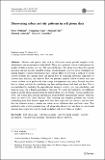Discovering urban activity patterns in cell phone data
Author(s)
Widhalm, Peter; Yang, Yingxiang; Ulm, Michael; Athavale, Shounak; Gonzalez, Marta C.
Download11116_2015_Article_9598.pdf (2.120Mb)
OPEN_ACCESS_POLICY
Open Access Policy
Creative Commons Attribution-Noncommercial-Share Alike
Terms of use
Metadata
Show full item recordAbstract
Massive and passive data such as cell phone traces provide samples of the whereabouts and movements of individuals. These are a potential source of information for models of daily activities in a city. The main challenge is that phone traces have low spatial precision and are sparsely sampled in time, which requires a precise set of techniques for mining hidden valuable information they contain. Here we propose a method to reveal activity patterns that emerge from cell phone data by analyzing relational signatures of activity time, duration, and land use. First, we present a method of how to detect stays and extract a robust set of geolocated time stamps that represent trip chains. Second, we show how to cluster activities by combining the detected trip chains with land use data. This is accomplished by modeling the dependencies between activity type, trip scheduling, and land use types via a Relational Markov Network. We apply the method to two different kinds of mobile phone datasets from the metropolitan areas of Vienna, Austria and Boston, USA. The former data includes information from mobility management signals, while the latter are usual Call Detail Records. The resulting trip sequence patterns and activity scheduling from both datasets agree well with their respective city surveys, and we show that the inferred activity clusters are stable across different days and both cities. This method to infer activity patterns from cell phone data allows us to use these as a novel and cheaper data source for activity-based modeling and travel behavior studies.
Date issued
2015-03Department
Massachusetts Institute of Technology. Department of Civil and Environmental EngineeringJournal
Transportation
Publisher
Springer US
Citation
Widhalm, Peter, Yingxiang Yang, Michael Ulm, Shounak Athavale, and Marta C. González. “Discovering Urban Activity Patterns in Cell Phone Data.” Transportation 42, no. 4 (March 27, 2015): 597–623.
Version: Author's final manuscript
ISSN
0049-4488
1572-9435